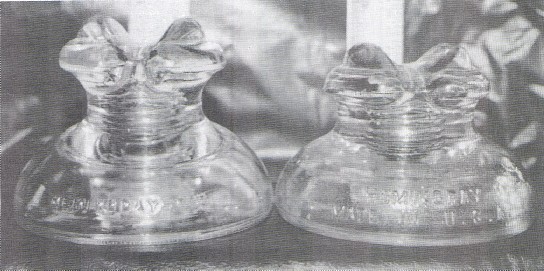Mac's Believe It or Not!
by John McDougald
Reprinted from "Crown Jewels of the Wire", October 1999, page 30
Just before heading to the printer with the 1999 version of the Price Guide
for "Insulators, A History and Guide to North American Glass Pintype
Insulators," I received photos and drawings from Gary Horstman, member of
the National Trail Insulator Club and collector from Brookville, Ohio.
Gary had
an unusual CD 232 Hemingray piece that he thought was different enough to warrant
a new CD number. Gary wrote: "These are photos of the CD 232 oddity
I came across. The embossing is CD 232 Hemingray [010]. The embossing is small,
and it's pretty blurred. The color is clear. The "mold" numbers are
"11-47.".
Here the difference starts. In the photos, the one on the
right is the standard 4-7/8" diameter and 3-5/16" high. The one on the
left is 4-13/16" in diameter and 3-3/4" high. The neck seems longer,
making the ears higher than the standard one. (In fact, the whole top resembled
the CD 232.1 to me). The inner skirt is longer; within 3/16" of the base.
The neck is narrower; 2-1/8" in diameter as opposed to 2-1/2"."
Over the last 10 years in preparation of publishing books on the North American
glass pintypes, numerous candidates for new CD number assignment has been
forwarded to N.R. "Woody" Woodward for his appraisal of their general
appearance, dimensions and field applications. He continues to diligently assess
all aspects of each new candidate.
Accompanying the return of Gary Horstman's
letter and photos were the following comments from Woody: "I have not seen
this insulator. I suspect it is the your [010] in the price guide. It has the
post-war style embossing, the "D" dropped, HEMINGRAY - 513 with MADE
IN U.S.A. on the reverse, with mold and post-war date under. I have never seen
this insulator.
Although some of the others (as [040] are probably post-war - knurled base
rim) the embossing indicates they were made in old molds with the 0-4 marking.
Number of dots would indicate date of manufacture; but on those power pieces the
dots above HEMINGRAYare seldom legible.
Therefore with 1/2" taller and
generally different configuration (including "neck" and inner skirt),
I'm going to assign CD 232.2 to the 1947 mold set. CD 232.1 is the first
design for that insulator, and has the very long inner skirt with the rest of the
insulator about the same as CD 232."

CD 232.2 on left, with CD 232 on the right for comparison.
Research is an ongoing process. With the publication of the 1999 Price Guide,
there have been many contacts from individuals who have located embossings not
listed in the price guide. And, as they have made them known to me, I have
placed them into the database for future updates to the price guide. The guide
serves as a pricing reference, BUT, more importantly a way of tracking the many
embossing configurations of each CD style. I won't attempt to solve the color
identification problem, for it is most difficult for any two individuals to
agree on every color, let alone the hundreds of people that use the guide. The
permission to use the Consolidated Design scale drawings developed by N.R.
Woodward has greatly enhanced the 1999 Guide's use. Maybe someday a standardized
color identification system, such as SpecTru developed by Mark Lauckner, will be
incorporated.
I encourage those of you who have found new listings to send them
to me for entry. The job becomes enormous when a new revision is in the works if
everyone sends additions at the last minute. It makes it so much easier if they
are entered as they are found.
| 